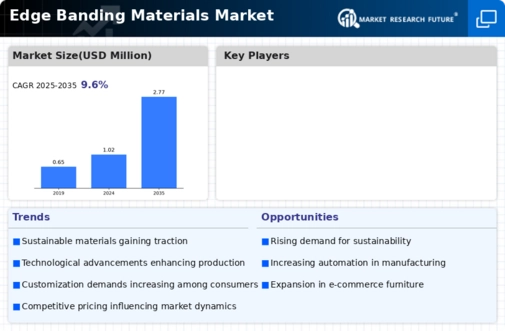Market Trends
Key Emerging Trends in the Edge Banding Materials Market
Currently, there are significant trends in the Edge Banding Materials market that reflect the continuously changing demand and applications mainly within furniture and interior design industries. Edge bandings play an important role in improving aesthetics as well as durability, which is highly required for finishing furniture pieces properly.
The market also shows another trend towards decorative and sustainable options for edge bandings. With raising concerns about the environment, manufacturers are using recycled or renewable sources to produce eco-friendly edging solutions. This is consistent with the wider trend towards sustainable practices in the furniture business where environmentally responsible interior design solutions are desired.
Nevertheless, trends in the edge banding materials market are largely influenced by furniture manufacturing companies. The desire for customized modular furniture solutions is driving product development in this segment of the industry. For instance, several edge banding providers have been able to offer multiple colors textures and finishes according to customers’ needs. This change coincides with modern consumers’ preferences for more personalized aesthetically appealing furniture designs.
Technology advancements also characterize current trends in edge banding materials industry. Advanced technologies like 3D printing and laser edge banding helps create intricate pattern on these materials thus making them look artistic than before. Some examples include borderless edgings which makes fitting perfect since it gets rid of joints that can bring down its beauty because they exist only on paper while creating beautiful looking furniture items. Therefore these technological changes enhance adaptive nature of this sector that enables it provide cutting-edge solutions for dynamic needs in modern furniture and interior design markets.
Moreover, trends in the edge banding materials market are influenced by players in construction and architecture. These materials are not only used for furniture but also in architectural elements like wall panels, doors and countertops. The use of high quality aesthetic edge bandings that appeal to vision is driven by the trend towards modern sleek interiors in buildings. This transformation came about because of the growing importance of aesthetics and design features in both residential as well as commercial spaces.
The global edge banding materials market has been seeing an increase in the adoption of digital platforms as well as e-commerce channels. Online platforms have increasingly become major distribution outlets for edge banding material allowing manufacturers to reach a larger target population while at the same time providing customers with more options to choose from. Digitalization has simplified the process of procuring edge banding materials making it more user-friendly to both businesses and consumers.



Leave a Comment